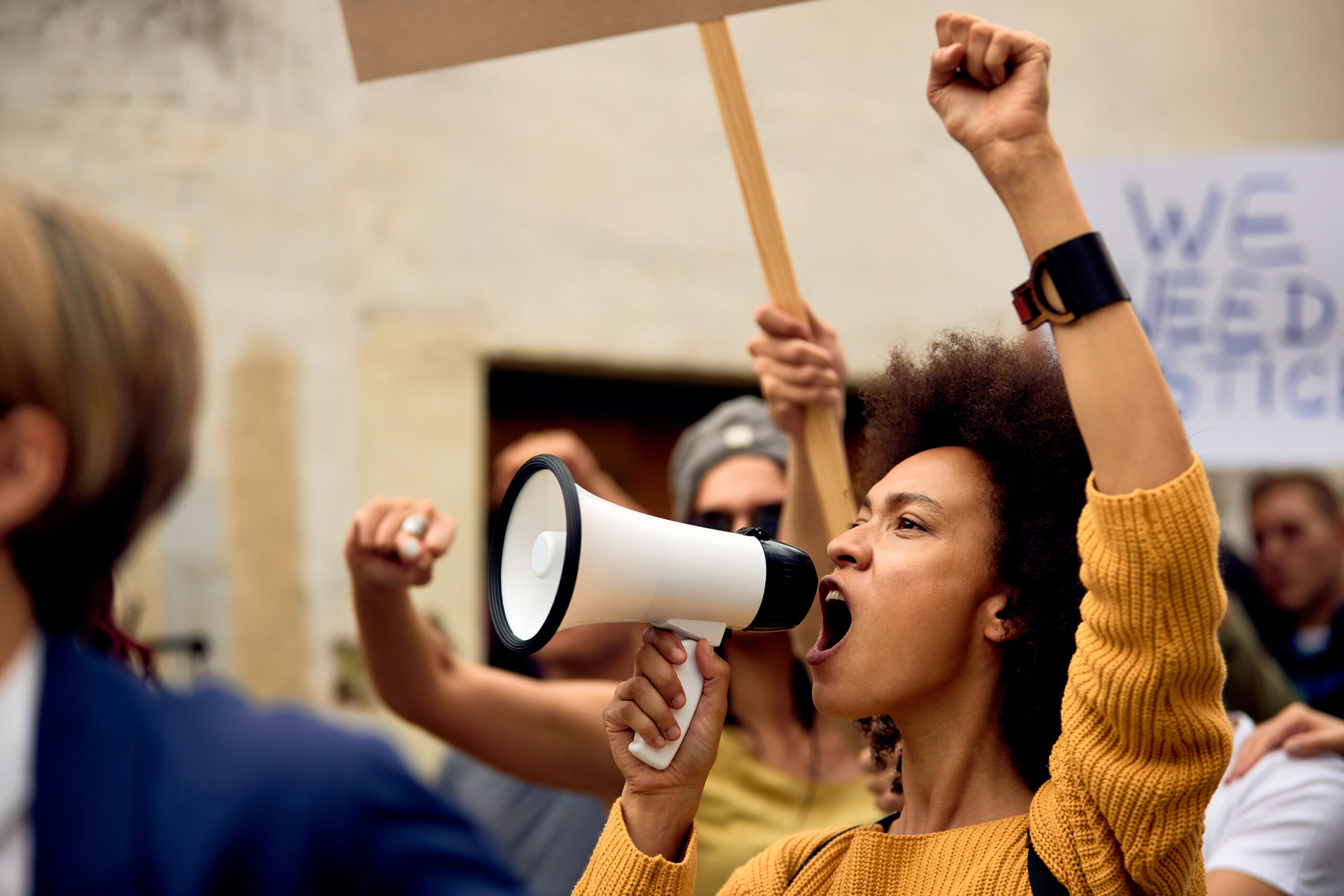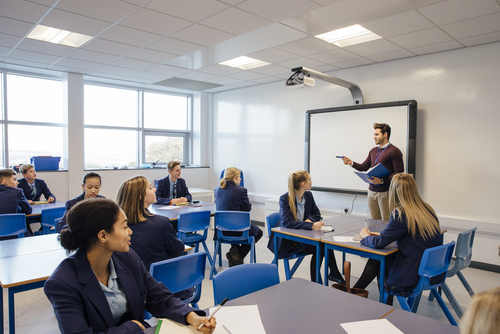As the third anniversary of the murder of George Floyd arrives this week, thoughts will turn to how to use his story in assemblies and lessons about racial justice and the role of the police. Fundamentally, we need to encourage students to explore questions about the wider context of his tragic death.
On a hot July day in 1967 Newark, New Jersey, Black taxi driver John Smith allegedly drove around a double-parked police car at the corner of 7th Street and 15th Avenue. He was subsequently stopped, interrogated and arrested before being severely beaten whilst in police custody. Rumours spread that Smith had been killed. In fact, he had been taken to a local hospital to recover from his significant injuries. Incensed by this example of police brutality, the protests of Black residents escalated into full scale uprising as the National Guard were called in to restore order. Five days later, 26 people were dead, hundreds injured and over a thousand arrested.
Over half a century later onlookers watched helplessly as George Floyd was suffocated to death by White police officer Derek Chauvin in Minneapolis, Minnesota. The police had been called after he used a counterfeit $20 note to pay for some cigarettes. The tragic sight of Floyd pleading in despair, ‘I can’t breathe’, was shared on social media and spread around the globe. A man having the breath squeezed out of him during a generation-defining pandemic that attacked the respiratory system of its victims added grim and cruel irony to a needless death. The protests that followed ignited urban America more ferociously than at any point since the year after the long hot summer of 1967, when the nation convulsed in response to the assassination of Martin Luther King Jnr.
This week we commemorate three years since the murder of George Floyd and in some history lessons and assemblies there may be a focus on his story. Floyd’s death and the brutal beating of John Smith are just some of the tragic acts in a wider history that must be tackled in any discussion about his legacy. We must move beyond a simple focus on the terrible human tragedy his murder represents and place it in the wider narrative of racism and police brutality.
Almost as soon as slavery ended in America, White southerners used law enforcement to control the Black population. The Black Codes that were passed by many of the former Confederate states criminalised vagrancy and enabled the arrest of Black men without fixed employment. In the decades that followed, an extensive system of controls was firmly enshrined in the social and economic structures of the American South, what Douglas Blackmon has called, ‘slavery by another name.’ Law enforcement was used to oppress the Black population rather than protect them. This was the context of the urban disorder of the mid-twentieth century which saw cities burn during the long hot summers of the 1960s. Race ‘riots’, so termed, were almost always expressions of rebellion in the face of police brutality.
The trigger for violence in the Detroit uprising of 1967 was a police raid on an after-hours bar. Following days of violence that resulted in over forty deaths, President Johnson spoke of the urgent need for ‘an attack – mounted at every level – upon the conditions that breed despair and violence’. The policy decisions taken by Johnson and those who followed him in the White House focused, however, not on social programmes to tackle poverty and marginalisation, but on law and order. In 1968 the Omnibus Crime Control and Safe Streets Act pumped significant government funding into the infrastructure of law enforcement. Between 1965 and 1970 there was a 2,900% increase in federal funding for local police forces.
The ‘War on Crime’ and ‘War on Drugs’ that followed in the 1970s and 1980s used police forces as a tool of social control and subjugation that criminalised a significant proportion of the young Black male population. In 2013, when the killer of 17-year-old Trayvon Martin was acquitted of murder, despite pursuing the high school student and shooting him, simply because he looked suspicious, three female activists began a movement with the social media post #BlackLivesMatter. That movement grew following the fatal police shooting a year later of Michael Brown in Missouri, and the choking of Eric Gardner in New York by an officer using a prohibited restraint technique.
So, the larger tragedy of George Floyd’s murder is how entirely unexceptional it was. The video of his death was simply the haunting visual of a recurring nightmare from which Black America cannot wake up. At specific points in time, like when the merciless beating of Rodney King was captured on videotape in 1992, the rest of society is confronted by the fear of police brutality that is a feature of everyday Black existence. Those who wish to neutralise the potency of the Black Lives Matter movement, pointing to the radical agenda of some of its supporters, or who peddle the disingenuous assertion of a colour-blind world in which ‘all lives matter’, wilfully miss the point. Black Lives Matter is a plea for recognition that the contrary has so long been the case. It is a cry for justice in a society where Black life is treated cheaply and police violence has so long been the servant of White supremacy.
In early June 2020, as protests sparked by Floyd’s death swept through London, Black British actor John Boyega, addressed a crowd in Hyde Park. ‘I need you to understand how painful it is to be reminded every day that your race means nothing.’ Understanding is not solely achieved through empathy; it requires active cognisance of context. We need to help students reach a considered comprehension of the reasons for the Black Lives Matter movement and that means exploring the relationship between race and policing in the UK too.
The 1824 Vagrancy Act was designed to stop people begging and living rough in Victorian Britain. Motivated by a desire to tackle the social problems caused by the demobilisation of soldiers at the end of the Napoleonic Wars, it allowed police to stop and search ‘suspected persons’ without a warrant. The ‘Sus’ laws were increasingly used by officers in the 1960s and 1970s to police the growing Black communities in urban areas. Many young Black males were stopped and searched under suspicion that they were carrying drugs or weapons. According to the police’s own figures, in London in 1979 a Black population of just over 4% accounted for 40% of all individuals stopped and searched.
An already tense relationship between the police and Black communities was heightened in 1981 when Operation Swamp 81 used plain clothes officers on the streets of Black neighbourhoods to try and deter crime. Police brutality was the trigger for the Brixton and Toxteth riots of that year. Lord Scarman was commissioned to investigate the urban disorder and concluded in his report that, as well as historical, social and economic structures that provided the context for the uprisings, police brutality was a significant cause. He recommended the scrapping of the ‘Sus’ laws and greater efforts to develop constructive dialogues between the police and the Black communities they served. ‘Sus’ was repealed and eventually replaced in 1984 with the Police and Criminal Evidence Act. This new legislation was not, however, written in response to racist police practices. The provision that officers could only stop and search individuals they had ‘justifiable, reasonable grounds’ for suspecting of possessing illegal or stolen goods had little practical impact on reducing racial discrimination in policing. In 2000, section 44 of the Terrorism Act allowed racial profiling as a counter-terrorism measure. In the same month that Boyega and his fellow protestors took to the streets of London in response to the murder of George Floyd, the Met police were forced to reveal that even though the Black population of the capital was 12%, Black people accounted for 26% of all fines and 31% of all arrests for breaches of lockdown rules.
In a recent report produced by the Children’s Commissioner, Baroness Casey, she pointed to the clear racist attitudes within the Met police. This, almost twenty-five years after the McPherson Report found the police service to be ‘institutionally racist’. Figures show that between 2018 and 2022 Black school students were eleven times more likely to be strip searched by the police than their White peers. It is still the case that if you are young Black and British your interactions with a police force supposed to serve and protect are clouded by fear and distrust. This is the reality for many students who bring an all too relevant lived experience to any discussion of the Black Lives Matter movement.
George Floyd died not only because a single White police officer failed to respect his basic civil rights but because of a systemic, institutional, attitudinal cancer on racial justice and human decency. It is malignant and malevolent, and we must shine the full glaring light of truth on it, otherwise we fail to teach our students a comprehensive story, and we fall short of honouring the lives of George Floyd and countless other victims of police brutality.
Potential questions to prompt discussions with students –
How should we remember George Floyd?
Has the death of George Floyd led to changes that will make a long-term difference?
Is it time to think about how the police operate? Do we need reforms in the way police are trained?
To what extent is it possible to remove any influence of racism on the way the police operate?
Free lesson plan
Find out more about approaching Black Lives Matter – protest, reform and the search for justice with your KS3 students using this lesson from Black British History KS3 Teacher Resource Pack, the award-winning customisable teacher pack that helps you shine a light on the importance of Black British history in your classroom.
You may also be interested in
Black history is British history, Black British History – Hidden faces, important stories
Dr Simon Henderson has been teaching history for twenty years with experience at all secondary key stages as well as undergraduate level. He has written widely on race relations and the Black freedom struggle and organised events for students to explore the history of race relations. He is also the co-author of Black British History KS3 Teacher Resource Pack, winner of the Teach Secondary Awards 2022 curriculum impact category.



